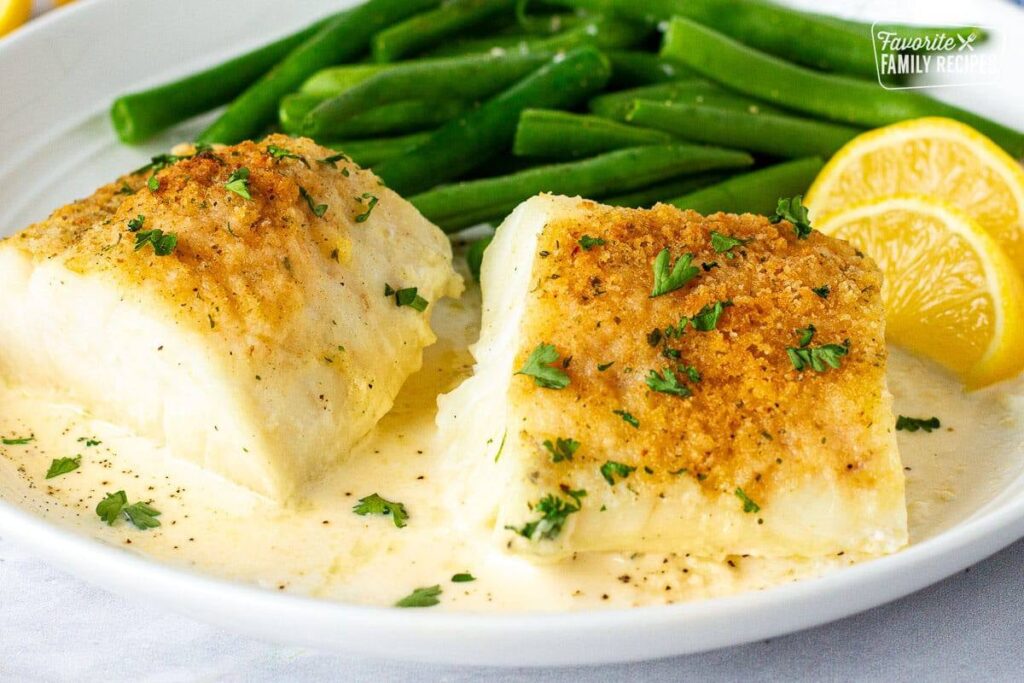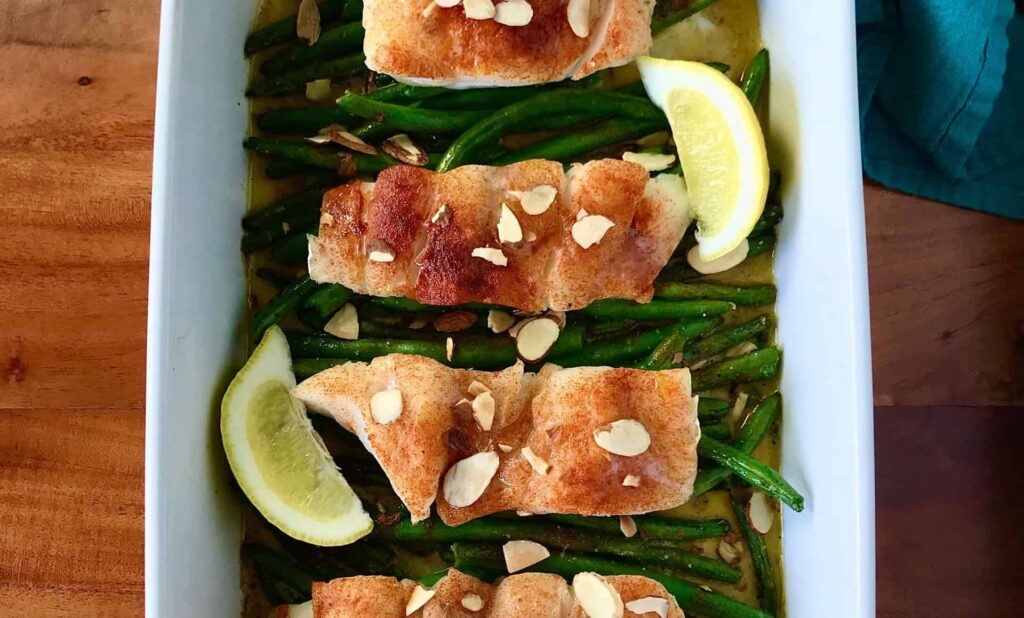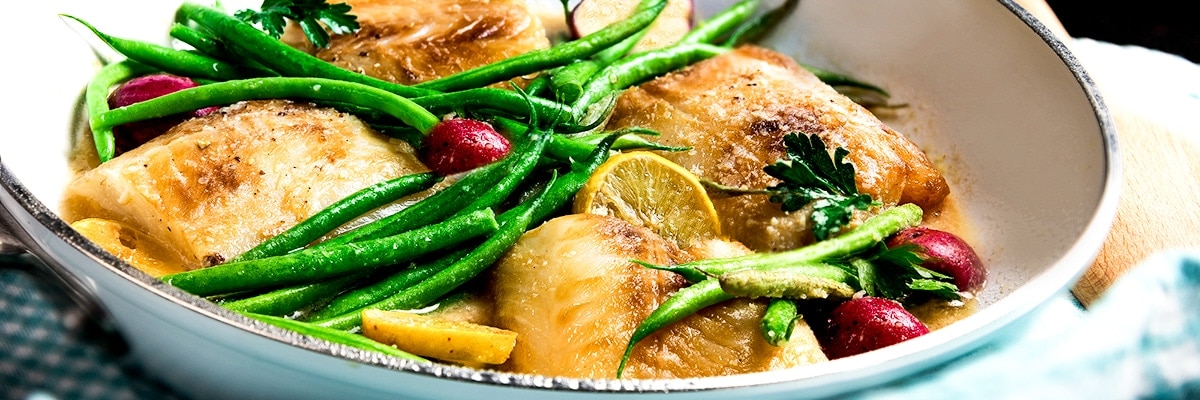In the realm of healthy, quick dinners, few dishes combine simplicity and nutrition quite like baked cod with green beans. This elegant yet effortless meal features flaky white fish fillets roasted alongside crisp-tender green beans, often enhanced with fresh herbs, lemon, or garlic for a burst of flavor. It’s a staple in Mediterranean-inspired diets, low in calories but high in protein and fiber, making it ideal for weight management, heart health, and busy weeknights. Whether you’re a seafood novice or a seasoned home chef, this guide will equip you with everything from foundational recipes to advanced variations, backed by nutritional insights and practical advice.
Baked cod with green beans isn’t just a meal; it’s a smart strategy for incorporating more omega-3s and antioxidants into your routine. Cod, a lean white fish, provides high-quality protein without the heaviness of red meats, while green beans add vitamins and crunch. According to health experts, this pairing supports everything from muscle repair to digestive wellness. For more seafood inspiration, explore our internal healthy fish recipes section. Externally, sites like EatingWell offer evidence-based recipe ideas that align with modern wellness trends.

This comprehensive article—clocking in at over 3,500 words—delves into the history of this dish, its impressive health perks, step-by-step recipes (including seven delectable variations), pro tips for perfection, and answers to your burning questions. By the end, you’ll be ready to fire up your oven and create a restaurant-worthy dinner in under 30 minutes. Let’s dive in!
A Brief History of Baked Cod and Green Beans as a Classic Pairing
The origins of baked cod trace back to ancient coastal communities where cod was a dietary cornerstone. Native to the cold waters of the North Atlantic, Atlantic cod (Gadus morhua) has been harvested since Viking times around 800 AD. Norse explorers prized it for its abundance and long shelf life when salted or dried, dubbing it “stockfish.” By the Middle Ages, cod became a trade commodity, fueling European economies and even influencing religious practices—Catholics abstained from meat on Fridays, turning to fish like cod as a Lenten staple.
Green beans, or string beans (Phaseolus vulgaris), entered the scene later. Originating in the Americas around 7,000 years ago, they were domesticated by indigenous peoples in Peru and Mexico. Spanish explorers brought them to Europe in the 16th century, where they quickly became a garden favorite. In France, haricots verts (French green beans) paired with fish in dishes like sole meunière, evolving into modern bakes.
The specific combo of baked cod with green beans emerged in the 19th-20th centuries amid health reform movements. In the U.S., figures like Dr. John Harvey Kellogg promoted simple, steamed or baked fish-and-veg meals for vitality. Post-WWII, as frozen cod and canned beans became accessible, this dish symbolized affordable nutrition. Today, it’s a global go-to: in Portugal, it’s bacalhau com feijão verde; in Scandinavia, it’s torsk med bönor.

This fusion reflects sustainable eating—cod fisheries are now MSC-certified for eco-friendliness. For deeper dives, our internal history of seafood page covers Viking cod lore. Externally, the Smithsonian’s food history archives detail how beans globalized.
Understanding this backstory highlights why baked cod with green beans endures: it’s nutritious heritage on a plate. Now, let’s explore why it’s so good for you.
Health Benefits of Baked Cod with Green Beans: A Nutritional Powerhouse
Baked cod with green beans isn’t just delicious—it’s a synergistic duo loaded with nutrients that bolster overall wellness. Starting with cod: this mild fish is a lean protein source, delivering about 20 grams per 4-ounce fillet with only 90 calories and minimal fat (less than 1 gram). It’s rich in B vitamins, particularly B12 (for nerve health and red blood cell formation) and B6 (for metabolism), plus selenium, an antioxidant that shields cells from damage. Omega-3 fatty acids, though lower than in salmon, still support heart health by reducing inflammation and triglycerides.
A 3-ounce serving of cod provides 50% of your daily selenium needs, aiding thyroid function and immunity. Phosphorus in cod strengthens bones, while its low mercury levels (safer than tuna) make it ideal for frequent consumption—up to three servings weekly for most adults, per FDA guidelines.
Enter green beans: these emerald gems are low-carb (7 grams per cup) and fiber-packed (3 grams per cup), promoting satiety and gut health. They’re vitamin K powerhouses (over 40% DV per cup), essential for blood clotting and bone density. Folate supports DNA synthesis, while vitamin C boosts collagen for skin and immunity. Together, this dish fights oxidative stress—cod’s selenium pairs with green beans’ antioxidants to lower chronic disease risk.
Calorie-wise, a full serving (4 oz cod + 1 cup beans) clocks in at ~150 calories, perfect for weight loss. It stabilizes blood sugar thanks to fiber and protein, benefiting diabetics. Heart perks? Omega-3s and potassium (from beans) regulate blood pressure. For athletes, the protein aids recovery; for seniors, B vitamins combat fatigue.
Potential downsides: Cod’s mild allergies are rare, but overfishing concerns favor sustainable sourcing. Green beans may cause bloating if raw—baking mitigates this. For more on superfoods, visit our internal nutrition benefits hub. Externally, https://tastetrove.netbreaks down cod’s profile.
This meal aligns with diets like Mediterranean or keto (swap beans for low-carb alts). Infographic below summarizes key stats.
| Nutrient | Cod (3 oz) | Green Beans (1 cup) | Daily Value % (Combined) | Benefit |
|---|---|---|---|---|
| Protein | 15g | 2g | 34% | Muscle repair, satiety |
| Vitamin B12 | 1.5µg | 0 | 63% | Energy, nerves |
| Vitamin K | 0.1µg | 48µg | 42% | Bone health, clotting |
| Fiber | 0g | 3g | 11% | Digestion, heart |
| Selenium | 37µg | 1µg | 70% | Immunity, thyroid |
| Calories | 70 | 31 | Low | Weight management |
Basic Recipe: Simple Baked Cod with Green Beans for Beginners
Mastering the basics is key to confidence in the kitchen. This foundational recipe serves 4, preps in 10 minutes, and bakes in 20—total time under 30. It’s forgiving, scalable, and uses pantry staples.
Ingredients
- 4 cod fillets (4-6 oz each, skinless)
- 1 lb fresh green beans, trimmed
- 2 tbsp olive oil
- 2 garlic cloves, minced
- Juice of 1 lemon
- 1 tsp dried thyme or fresh herbs
- Salt and pepper to taste
- Optional: Lemon slices for garnish
Instructions
- Preheat Oven: Set to 400°F (200°C). Line a sheet pan with parchment for easy cleanup.
- Prep Veggies: Toss green beans with 1 tbsp oil, half the garlic, salt, and pepper. Spread evenly on half the pan.
- Season Fish: Pat cod dry. Rub with remaining oil, garlic, thyme, lemon juice, salt, and pepper. Place on the other half of the pan.
- Bake: Roast 18-22 minutes until cod flakes easily (internal temp 145°F) and beans are tender-crisp. Broil 1-2 minutes for char if desired.
- Serve: Squeeze extra lemon over top. Pair with quinoa or rice.
Per serving: 180 calories, 25g protein, 10g carbs, 6g fat. Pro tip: Frozen cod works—thaw first for even cooking. For variations, see below. Our internal beginner baking guide has more. Externally, Feel Good Foodie shares a tomato-twist.

This base unlocks creativity—next, seven variations to keep your menu exciting.
7 Delicious Variations: From Lemon-Herb to Spicy Cajun
Variety prevents boredom while maximizing nutrients. Each twist builds on the basic recipe, ready in 30 minutes or less. We’ve curated seven, inspired by global flavors.
1. Lemon-Herb Mediterranean Baked Cod with Green Beans
Infuse with oregano and olives for a Greek vibe. Add 1/2 cup cherry tomatoes and 1/4 cup olives to beans; top cod with 1 tsp oregano and feta crumbles post-bake. Bake as directed. Boosts vitamin C; 200 calories. Ideal for summer.
2. Garlic Parmesan Crusted Cod with Roasted Green Beans
For crunch, mix 1/4 cup breadcrumbs, 2 tbsp Parmesan, and 1 tsp garlic powder. Press onto cod; bake. Sauté beans with extra garlic. 15-minute broil for golden crust. Protein-packed at 28g; kid-friendly.
3. Spiced Butter Baked Cod with Almond-Topped Green Beans
Melt 2 tbsp butter with 1/2 tsp smoked paprika and cumin; drizzle over cod and beans. Toast 1/4 cup almonds for topping. Paleo-approved, with anti-inflammatory spices. 220 calories; freezer-friendly.
4. Pesto-Crusted Cod with Lemon Green Beans
Spread 2 tbsp pesto on cod; bake with beans tossed in lemon zest. Serve over couscous. Omega-3s shine; 210 calories. Quick for weeknights.
5. Cajun-Spiced Cod with Bell Pepper Green Beans
Rub cod with 1 tsp Cajun seasoning. Add sliced bell peppers to beans for color. Zesty and low-carb; supports metabolism with peppers’ capsaicin. 190 calories.
6. Italian-Style with Potatoes and Green Beans
Layer halved baby potatoes under cod; bake longer (35 minutes). Drizzle with balsamic. Hearty, 300 calories; great for meal prep.
7. Asian-Inspired Ginger-Soy Cod with Sesame Green Beans
Marinate cod in 1 tbsp soy sauce and ginger; bake. Toss beans with sesame oil and seeds. Umami-rich; gluten-free option with tamari. 175 calories.
These keep things fresh—rotate weekly. For more, our internal variation recipes. Externally, Pioneer Woman has cracker-crusted ideas.
Essential Tips for Perfect Baked Cod with Green Beans Every Time
Elevate your game with these hacks. Choose fresh cod: Firm, translucent fillets from sustainable sources (look for blue MSC label). Frozen? Thaw in milk for tenderness.
Sheet pan supremacy: Use one for efficiency—line with foil for no-stick. Oil generously to prevent drying; cod’s low fat needs it.
Timing tricks: Beans take longer—start them 5 minutes early if separate. Test doneness: Cod at 145°F; beans bright green, not mushy.
Flavor boosters: Acid (lemon/vinegar) cuts richness; herbs like dill or parsley add aroma. Salt post-bake to avoid toughness.
Common pitfalls: Overcooking dries fish—err under. Soggy beans? Pat dry pre-toss. For sides, roasted potatoes or quinoa complement.
Storage: Fridge up to 3 days; reheat at 300°F. Freeze cod/beans separately for 1 month. Safety: Cook to 145°F to kill bacteria.
Wine pairing: Crisp Sauvignon Blanc. Our internal kitchen tips blog expands on this. Externally, Blue Apron demos techniques.

